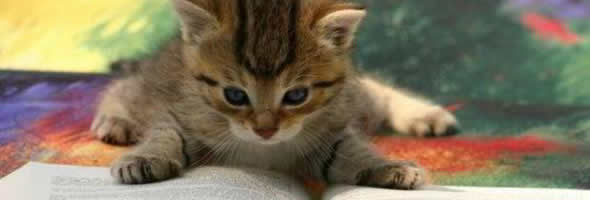
With the recent release of Ulduar, most raiding WoW players have upped their reading and research. At this point in the progression curve, the ability to extract and process information from different resources on the web is what gives some players a critical edge in strategy or play. I have been blogging since October 2008, but I’ve been reading WoW blogs for a lot longer. However, in the interest of full disclosure, the thing that has inspired me to write a series of meta-blogging posts is my experience teaching college-level literature classes. Since I work in a foreign language, my daily task is teaching students not only how to write well, but how to read. My firm belief is that in order to be a good writer, you first have to be a good reader. If you follow these simple tips, your blog reading will become a more informative and rewarding experience, and your blog writing will probably improve as well.
Tip #1: Know Your Medium
The biggest thing I learned from Matticus when I started working for the site is that blogs differ from traditional writing. Blogs have their own set of rules and conventions, and a thoughtful reader should be aware of them. The following are what I consider the primary blog conventions.
A. Blogs are designed to be skimmable. Writers tend to bold their most important information.
B. Blogs use personal experience as their evidence. Even when facts and numbers are cited, the personal is always paramount.
C. Third, blogs are constrained by design. Bloggers have to develop a shorthand both to combat space restrictions and to keep from revealing too much personal information about the writer and his or her acquaintances.
How does knowing how blogs work make me a better reader? First, because I know that blogs are meant to be skimmable, I read the bolded or highlighted text first in order to find the post’s thesis. At this point you may prioritize and choose to read or not to read. I always choose to read, even if the post has no clear argument, but that’s just me. Identifying the thesis statement might sound trivial, but if you don’t know what you’re reading about, how can you react?
Secondly, because I know that blogs as a genre extract their primary evidence from personal experience, I read any narrative with a critical eye. I don’t take it as absolute “truth,” because I know that autobiography, as a subjective genre, is a prime spot for literary manipulation. When I read someone’s personal experience, I take it as a metaphor for something greater. Sometimes a less skilled blog writer will not provide a thin red thread of meaning that readers can follow through the labyrinth of narrative, but usually a personal account has a “point.” Personal accounts have become my favorite aspect of reading blogs. Because I am attentive to their details, I can sometimes extract more from them than the original writer intended. If you are one of those types who can learn from the experience of others, the personal account of people’s successes, and even more particularly, failures, can enrich your game experience.
Third, I recognize that blog writers are bound by the constraints of their medium. I don’t expect the fullest possible exploration of any topic. I try to read between the lines–many things must be left unsaid to protect the innocent or the guilty, and I depend on the writer’s tone to pick up some of the implications of their argument, especially if I’m dealing with a personal narrative. The public nature of blogs means that writers feel the need to “protect” their real-life and in-game acquaintances, sometimes to the point of obscuring the events that prompted them to write. Regarding the “shorthand” of different blogs, my best advice is to read the same blog over the course of several weeks. The best writers have a strong personal style that allows them to present concepts in an abbreviated form. Familiarity breeds comfort in this case.
Tip #2: Read for Detail
Just because blogs can be skimmed, it doesn’t mean they should be. If you’ve read through the bolded sections, and the post topic interests you, it’s time to go deeper. If you’re reading a guide, and you intend to use that information, take notes. Nothing is more inconvenient than having to go back to a webpage you read earlier in the day 30 seconds before you pull a new boss in order to get the exact name of his abilities. If you have to do that, you didn’t “forget” the information–you never memorized it in the first place. I always tell my students that writing things down–particularly with pen or pencil–makes it easier to create the long-term memory. However, guide-type posts are not the only ones you want to read carefully. Posts on class mechanics or class changes, best-in-slot lists, and opinion pieces on controversial topics actually draw more comments than guides. Many of the people who comment, however, are sloppy readers, and nothing annoys a blogger more. Here’s a little test that, in my mind, you must pass in order to comment on your favorite blogs.
1. Who wrote the article? Go ahead and laugh, but the comments for many of my past posts (I’d say at least 25 in total) identified the author of the post as Matticus, not me. Nothing gets on my left nerve quicker a lack of recognition for my efforts. My right nerve, in case you’re wondering, is reserved for my annoyances with students who don’t come to class. Even if you’re reading on RSS, you need to be able to identify the author. In order to test your reading skills, think of your ten favorite blogs or authors. If you were to receive a stack of papers with the blog posts on them, without any images, formatting, or bylines, you should be able to identify the author. If you can’t, you’re not reading well enough to catch an author’s style or tone. Style refers to the mechanics, rhetorical figures, and structure that an author uses, while tone refers to their word choice, overall attitude, and “sound.” If you can’t understand the style and tone, your comment runs the risk of misunderstanding the post altogether. You might have missed the humor or irony if you’re not reading for it.
2. What is the date of the article? My second pet peeve about blog commenters arises from reading negative comments on outdated posts. For example, one commenter noted that my observations about Ulduar mana regen were completely wrong. Of course they were! The post in question was written on February 7, before the PTR or concrete numbers were available. If you’re going to criticize someone’s argument, make sure you understand the context in which their article was written.
3. What is the article about? Certain blogs have certain preoccupations, and articles run in series. In addition, multiple blog authors enter into dialogue with each other. If you’re just reading one thing, you might be reading in a vaccuum. Before you press that comment button, try to make sure you know what the actual topic is.
4. What argument does the writer make? The classic, and in my mind the best, way to construct an argument is to have a thesis and an antithesis–or in other words, a point and a counterpoint. I see some commenters read so quickly that they mistake someone’s antithesis for their thesis. The commenter thinks they’re arguing against the blog poster when in fact they’re reinforcing the original author’s claim. These comments usually have me shaking my head.
5. What are the author’s strong points? I learned in my grad school classes that while anyone can identify a literary critic’s flaws, it’s much more difficult to pinpoint their strengths. Before you comment, especially if you’re going to argue with the writer, make sure you’re able to understand them well enough to identify the potential merit of the post. It’s rare that a seasoned blogger creates an entirely off-the-wall argument–well, except for those who do it on purpose. As for those guys, you should be able to identify them by their tone and style.
Tip #3: Read Both Deeply and Widely
Some blog readers follow one or two blogs exclusively. In particular, I know of many readers who consult only WoWInsider and occasionally the outside posts that it links to. Learn to be critical of your media. One blog, even a great one like World of Matticus, is only one perspective. All blogs have a certain ideological slant, and if you’re not aware of that, it will influence you. However, if you just read random posts here and there, you’ll never understand any of the particular writers. The ideal blog reader will choose 10 or so writers or sites and consult them fairly regularly. How much reading you do depends on your time, but think about it this way. If you read just one guide or watch just one video of a boss fight, what is your chance of success? There’s only a slim chance that one specific strategy will work for your guild. However, if you read/watch 10 different guides, you have 10 potential paths to boss death. Even the most careless reader’s chance of success would go up.
Conclusions: The Benefits of Reading Critically
Reading isn’t easy, folks. We learn to do it in elementary school, but many of us grow up blind to all but the most obvious meaning of the things we read. Critical reading takes time and care, but the effort is well-spent. There is a certain delight in understanding a skilled writer’s metaphors or wry sense of humor. The process of careful reading, particularly when your reading material comes from writers who are worthy of imitation, can enhance your own writing. I urge you to beg, borrow, and steal style and inspiration from other writers. If I were giving advice on writing fiction, I would tell you to go read your favorite genre voraciously for a year, take notes on what you like and don’t like, and only then start your own novel. My advice to aspiring or current bloggers is much the same. Read authors you admire and let them teach you.













 Current DPS output for everyone has a limit: Your guild’s gear. In order to increase DPS, you either switch out tanks or healers and replace them with DPS. Every player added is another 4000-7000 DPS depending on the class.
Current DPS output for everyone has a limit: Your guild’s gear. In order to increase DPS, you either switch out tanks or healers and replace them with DPS. Every player added is another 4000-7000 DPS depending on the class.